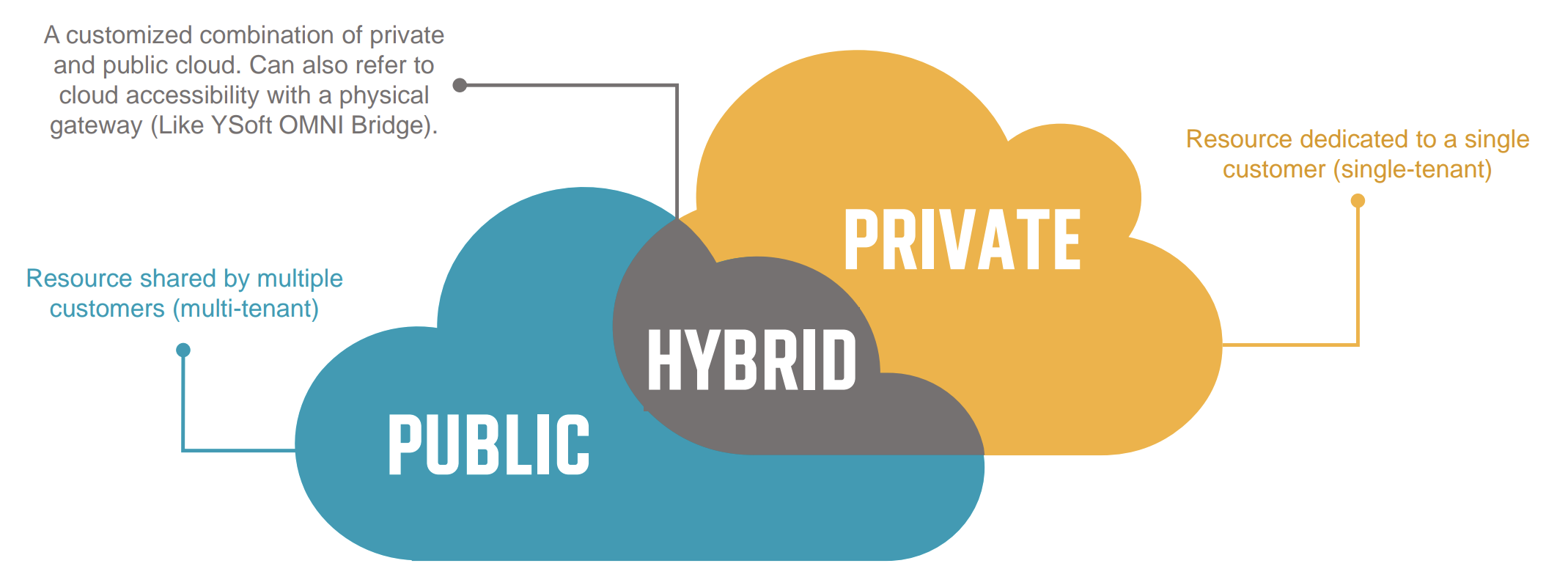What is cloud print? Or a cloud printing solution? What is even cloud computing? These days, the term “cloud computing” is everywhere. And while the questions are simple, in order to understand the answer, we need to explore its many layers.
Now that cloud infrastructure solutions are becoming the norm for IT departments, let's explore what they can do to improve the daily lives of IT professionals as they build the backbone of their digital enterprise.
Cloud computing is a concept that is easy enough to understand. Here's what it is:
Cloud computing lets you store and access data over the internet instead of storing data on a hard drive. For print, this means moving on-prem servers to a hybrid or pure cloud platform. Once migrated, a cloud print service links digital devices such as smartphones, PCs, tablets, and workstations with printer stations.
Cloud printing technology transforms the printing experience by eliminating the hassle of managing printer drivers or servers. It seamlessly connects printers and devices, enabling the printer to receive digital information and commands directly through the cloud.
There are many advantages to printing from the cloud. Not only does the cloud drive agility and efficiency across IT departments, but it also helps IT professionals stay organized while cutting back on costs and improving accessibility for their office users.
But how can cloud computing services lend themselves well to the world of printing infrastructures and alleviate the burden on IT teams? Get your answers in the following article.
What is the Cloud?
At its core, the Cloud is anything that you can access over the internet. When we say that something is ‘in the cloud,’ we’re saying that it’s possible to seamlessly access it remotely, wherever you are, via the internet.
Though the word is often used as a blanket term, there are in fact four types of cloud: public, hybrid, private, and multi-clouds. These are usually delivered in a service format, either Software-as-a-service (SaaS), Platform-as-a-service (PaaS), or Infrastructure-as-a-service (IaaS).

The lines between local and cloud computing can sometimes get blurry as the cloud is part of almost everything on our computers these days.
You can easily integrate a local piece of software (like Microsoft Office) that offers a set of web-based apps. That makes them both a local application and a version of cloud computing (‘web-based’ and ‘in the cloud’ are the same). Ultimately, Cloud solutions come in many forms:
3 Types of Cloud
- Public Cloud (multi-tenant): Public clouds, often associated with a service subscription offering, utilize shared infrastructure and resources, provided by a third-party cloud service provider (CSP) and accessible via the Internet.
- Private Cloud (single-tenant): Private clouds, also referred to as data centers, are housed within a company's infrastructure. These dedicated servers provide a secure and firewall-protected environment for storing and processing data.
- Hybrid Cloud: Hybrid cloud technology combines public cloud, private cloud, and on-premises infrastructure to build a cohesive and efficient IT infrastructure. With the help of a cloud gateway device, even legacy printers can be leveraged for cloud printing.
To learn more about Cloud printing and what it means to migrate, have a look at these 5 considerations for migrating from server to Cloud.
What is Cloud Print?
In traditional printing, print servers work by sending a message from the computer to the printer. They may either connect the printer and the computer with a network connection, wired or wireless.
Cloud printing solutions are managed print services that enable remote printing and allow users to print from any device on the network. A cloud print service connects digital devices like phones, laptops, and workstations with printer stations.
Cloud print eliminates the need for print drivers, and links the printer and device together, allowing the printer to receive digital information through a 3rd party data center (the cloud) and perform print workflows remotely.
The most popular way to take advantage of a cloud print service used to be through the Google Cloud Print service. Both Google Cloud Print Beta and Google Cloud Print were discontinued in early 2021.
On a positive note, many other Software-as-a-Service (SaaS) companies have come in to fill the gap. And though we may be biased, we have to say that SAFEQ Cloud gives all market options a fair run for their money, especially with its Chrome extension for printing.
Cloud printing is compatible with a wide range of printers, including both cloud-enabled printers and legacy printers. In order to enable cloud printing on legacy devices, a cloud print connector needs to be installed.
This connector acts as a bridge between the printer and the cloud, allowing seamless communication and print job transmission in a few easy steps.
What is a Cloud Printing Solution?
Cloud print platforms are a type of technology that allows printers to communicate with the cloud.
📖 Read on: Migrating to the Cloud with a Cloud-Centric or Cloud-Enabled Solution?
Printers can’t complete jobs through the cloud on their own, so they need to rely on a third-party program to connect the printer to the cloud. This program is usually offered as a form of Software as a Service (SaaS) or Platform as a Service (PaaS).
One example of a cloud print service is SAFEQ Cloud. SAFEQ Cloud is a SaaS cloud print software that streamlines all print infrastructure in the cloud and incorporates future-proof technology in a one-in-all cloud printing solution.
Not sure if a cloud print service is for you or which solution to pick? Here are 5 questions to ask when picking your preferred print solution.
Security is a crucial part of any such solution. When you ask yourself ‘What is Cloud Print?’, the answer has to sufficiently address the security compliance that comes with a serverless print option.
👉🏼 If you’re curious to learn more about the security measures necessary with cloud-first print, head over to our blog post on 10 mechanisms of a secure Cloud print environment.
How does Cloud Printing Work?
With cloud print services, you can print from any internet-connected device remotely. Without the constraint of a local network, print jobs are seamlessly routed from your computer, smartphone, or tablet to an internet-connected printer.
By securely transmitting print jobs over the internet, cloud print software operates within your network and makes printers accessible to end users.
This simplifies the process of printer discovery and ensures efficient delivery of print jobs. End users can easily locate their desired printers and send their print jobs directly from their devices, wherever they are.
Public cloud printing uses the power of a multi tenant SaaS environment to provide quick, straightforward printing solutions to an entire organization. It allows users to quickly discover printers and print from their devices without needing to set up driver installations.
Multi-tenancy is found in the cloud service option referred to as "Public cloud". Beyond that, you have the option to use a single-tenant solution (aka private cloud), or a hybrid solution with a private and public combination.

Cloud printing services replace the need to purchase and maintain servers simply to print. It also eliminates the time and costs associated with managing and patching the server, print drivers, and queues.
With a cloud solution, an administration portal offers an overview of all:
- Configurations
- Printers and queues
- Security and access control rights
- Authentication providers
- Print activities
SAFEQ Cloud allows administrators to automate the deployment process of printing within the organization, configuring just a PC Client to deploy to end-user computers / mobile devices.
The aim is to enable secure print release, or pull printing, that allows users to submit print jobs from their device and not initiate print until the user has been authenticated, using a PIN, swipe card, or QR code.
This minimizes the risk of confidential data falling into other people’s laps.

If you’re interested in seamlessly deploying your print infrastructure to a full cloud setup, a true cloud solution might be right for you. Via SAFEQ Cloud, we offer a Pure Cloud solution that lets you migrate every inch of your IT infrastructure to the cloud and say goodbye to print management.
See if adopting a future-ready cloud infrastructure is something for your business by having a look at the blog posts below:
→ Manage Cloud Print with Cutting-Edge True Cloud Solutions
→ 7 Ways Pure Cloud Solutions Drive Innovation Forward
What are the Main Advantages of Cloud Print?
- Modernize print infrastructure—by relying on Software as a Service (SaaS), you not only benefit from the cloud but also have the option to manage your service from afar.
- IT Helpdesk requests will be significantly reduced, as print problems often clog up the system.
- A cloud print service eliminates all needs for physical print servers, freeing up space and decreasing your electronic waste footprint.
- Cloud printing reduces carbon footprint and waste generation while contributing to a greener environment.
- Meet security and compliance standards and benefit from the safety that the cloud provides, and benefit from quick disaster recovery.
- A solution like SAFEQ Cloud is compatible with all major operating systems and printer device brands.
- Cloud software makes print a scalable service that can be expanded or reduced depending on your needs, at any given time.
- SaaS makes solutions like SAFEQ Cloud zero-management and automated to allow IT departments to focus on more meaningful work.
Ultimately, there are several reasons to move your print infrastructure to the cloud. With a cloud print server, you can start reducing print costs, amp up your print security (and avoid print spooler vulnerability), and chop out a significant piece of your current cloud print management and maintenance.
Cloud printing technology also helps boost productivity, thanks to its portability, immediate fulfillment, automation, and more.
→ Give Your IT Team a Break: 7 Productivity Benefits of Cloud Printing
Are There any Disadvantages to a Cloud Print Service?
Crash potential. When there are problems with a giant cloud host like Amazon Web Services or Microsoft Azure, companies that offer their services through these clouds are affected. The problems typically last for only hours, but that’s not much consolation at the time.
At Y Soft, we have a recovery point objective (RPO) of 24 hours and a recovery time objective (RTO) of less than 90 minutes to make sure that any crashes are handled fast and cause the least amount of latency for our customers. Even more, we have offline capabilities in place if our customers’ internet should be down.
Like any other technology, vulnerabilities can happen. With cloud print, these are both rarer and handled faster. At Y Soft, we have comprehensive Incident Management and Major Incident Management procedures in place to mitigate any potential security breach.
To get an idea of what vulnerabilities can look like, here’s a resource to read through:
→ How to Keep your Cloud Printing Safe from the Log4j Vulnerability
Who can Benefit from a Cloud Service?
When talking about cloud print software and moving your print to a cloud print service, we have a specific type of hero in mind.
When we think about who can benefit the most from a cloud-based print set-up, the most common image that comes to mind is a stressed-out in-house IT team—and it's true. Here’s why cloud print is an excellent solution for IT teams and the benefits it can offer other groups as well:
CIO/IT Teams
- Reduces IT admin workload by eliminating the need to maintain print servers and print queues
- Zero management ensures IT departments can focus on strategic work
- Reduces Helpdesk requests because users have access to an automated print deployment
- Ensures the best security features with state-of-the-art encryption
CTO/Technology Owners
- Consume print as a service rather than an overhead
- Demonstrates SAFEQ Cloud as an enterprise-ready platform
- SAFEQ Cloud helps accelerate cloud printing journeys thanks to high adaptability
- Relieves budgeting by removing physical server costs, allowing CTOs to focus on business needs
Managed Print Providers
- Assists organizations with their cloud setup
- Manages customers remotely
- Deploys devices and print services at a much faster rate
- Reduces the dependency that engineers have to visit physical sites
- Removes the need for providers to manage/patch/update, etc.
End Users
- The same user interface, regardless of device or location, simplifies the user’s experience and usage
- Direct print queues to users, utilizing location-aware printing
- Users automatically see their printers, wherever they are
- Users can print to and from any device or location
- User self-service for card enrolment, pin codes, and favorite printer settings
All types of Workforces
- On-site workforce
- Distributed workforce
- Co-working spaces
- Multi-location
- Single-location
At Y Soft, our experience is that SAFEQ Cloud works extremely well for businesses within the following industries:
Cloud Printing Solutions: Real-Life Examples
All of this sounds pretty great on screen, but what kind of difference can a cloud printing solution make in the real world?
When applied to day-to-day office life, cloud printing saves the IT team many hours of hassle and helps to streamline company processes and improve uniformity across a multi-location company operation. Check out how Intracoastal Realty a US-based real estate company used cloud print to ease employee operations and improve security.
Intercoastal Realty is far from the only company that’s seen incredible IT transformations as a result of migrating to a cloud service.
Dive into more inspirational examples of how cloud print management software reduces the burden on IT and makes print an independent, close-to-invisible background process:
Find our case studies right here → Customer stories
Final Points
While cloud print service tech can seem complex, in reality, it’s easy enough to understand. We hope you feel more confident about what goes into a cloud printing solution after reading the article.
Are you getting tired of print management? If you’ve had your "How does cloud print work?" question answered and now looking to get cloud-ready printers and a cloud print infrastructure, let's make sure that you’re as ready as you can be.
With experienced cloud providers and enablers like Y Soft, you can set up your cloud printer architecture in just 10 minutes.
To make sure you’re well equipped as you get to a stage where you no longer have to manage printers, click the button below to see what questions you need to ask yourself when choosing the right cloud print service for you:


.png?width=500&height=375&name=MicrosoftTeams-image%20(2).png)



